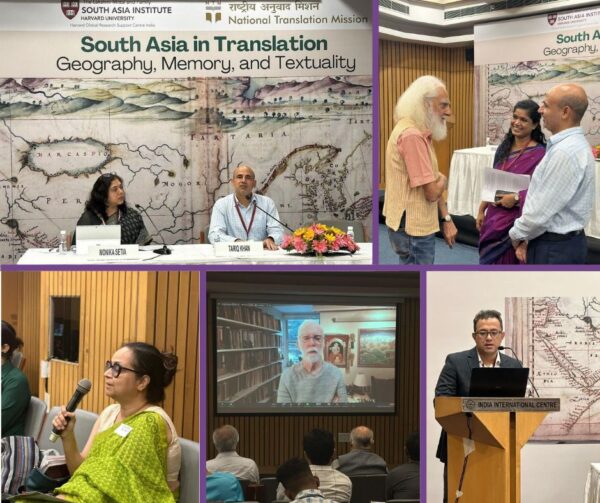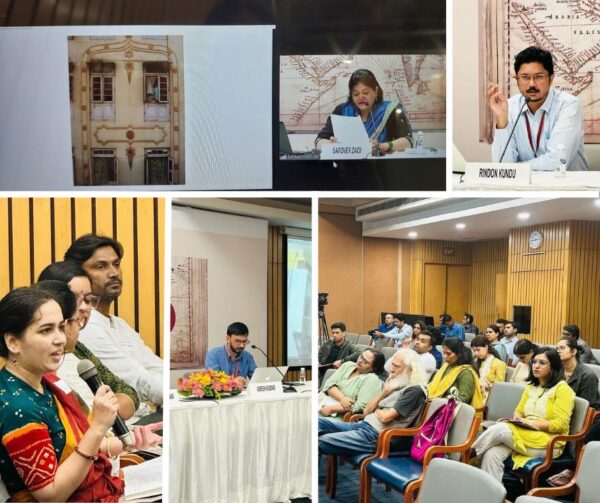South Asia in Translation: Geography, Memory, and Textuality
October 5 and 6, 2023
Organized by the Mittal Institute, Harvard University and
National Translation Mission, CIIL, Mysore, Govt. of India
 Day 1 of the conference opened with remarks from Monika Setia, India Associate Director, Mittal Institute and Tariq Khan, Officer-in-Charge, National Translation Mission. They spoke about the work on South Asia being conducted at the Mittal Institute and the translation work and emphasis on Indian languages at the National Translation Mission.
Day 1 of the conference opened with remarks from Monika Setia, India Associate Director, Mittal Institute and Tariq Khan, Officer-in-Charge, National Translation Mission. They spoke about the work on South Asia being conducted at the Mittal Institute and the translation work and emphasis on Indian languages at the National Translation Mission.
The keynote lecture, chaired by Prof. Vidyan Ravinthiran, Harvard University, was delivered by eminent poet and translator, Arvind Krishna Mehrotra. The lecture “Translation as Desire” followed the life and writing of the 15th century poet Rahim across geographical places and spaces of memory. “One day I felt like touching a book…” began the keynote lecture and took listeners on a journey across places and times.
The plenary lecture by Francis X. Clooney, Harvard Divinity School, “Worlds of Translation: Reflections on Some Larger Projects of “Translation” in the South Asian Context” was a sweeping and insightful view of the worlds of sacred-text translations in South Asia. Clooney examined the various translation strategies used in the region over the ages, and the manner in which different geographies shape texts differently in translation.
Day 2 began with the panel “Memory, Geo-spatiality, and Translation”. The session chaired by Annie Royson had Avishek Parui, IIT Madras and Rindon Kundu, Sri Sri University as speakers. Avishek Parui spoke about “Memory, Forgetting, and the Translated Text in a Geo-Digital Age”. His talk reflected on the various intersections between memory studies and translation and focused on the ways in which technology can be harnessed to translate geography and memory for a wider audience, and provide low-cost pedagogical tools in the areas of translation and memory. Rindon Kundu spoke on the subject of “Geo-modelling Translation Studies: Interweaving Translation Studies with Geometry and Geography”. He went back to the etymology of translation to emphasize the aspect of geographical displacement in translation and proposed the Brownian motion as one possible way of modelling the process of translation between languages.
The second panel “Translation, Displacement, and the Poetics of Landscape”, was chaired by Vidyan Ravinthiran. The first speaker in this panel, Shash Trevett, poet and translator based in the UK, spoke about the landscapes of classical Tamil poetry and analysed Sri Lankan Tamil poetry and its translation through the lens of trauma, exile, and landscapes. The talk walked participants through the various geographies in which Sri Lankan Poetry travelled through translation and was powerful reminder of the routes through which traumatic memory transforms onto poetic memory. Umesh Kumar, Banaras Hindu University, presented a paper, “Encountering Adhaantar: Some Notes” which compared two translations of Jayant Pawar’s play Adhaantar. This talk emphasized the place of the translator within a socio-cultural context, and their role in foregrounding displacement and devastation. The play, centered on the plight of Mumbai mill workers and the two translations, Kumar argued, are central to understanding how translations are shaped and evolve and the “attention” and “empathy” required to translate texts of this kind.
The last panel “Translation, Memory, and South Asian Cartographies” was chaired by Avishek Parui, and had three speakers, Chandrani Chatterjee, Savitribai Phule Pune University, Sarover Zaidi, Jindal School of Art and Architecture and Annie Rachel Royson, Mittal Institute, Harvard University. Chandrani Chatterjee presented a paper on “‘Translating’ the ‘City’: Re-visiting Some Nineteenth century Bengali Prose Fiction”. She presented an absorbing image of the city of Kolkata as it emerged in nineteenth century Bengali writing. The process of imagining and translating the city and its impact on the cartography and evolution of the city was cohesively argued by Chatterjee through her reading of Bengali texts. Sarover Zaidi in her talk “Horizons, Courtyards and the Languages of Architecture” presented the evolution of Indian Ocean geographies with the city of Mumbai as her focus. Her talk touched upon the themes of geography, memory, and the ‘staccato’ of languages heard in these cities. She spoke about “the many languages a space can speak” and evolving geographies and flatland politics. Annie Royson spoke about translation, geography, and memory as they emerge in sacred-text translations of the nineteenth century. Through her analysis of two Marathi Christian texts, Royson argued that translation has a critical relationship with geography and memory and that scared texts and translations must be read with attention while studying evolving geographies and ecologies in South Asia.
The conference was well attended both in-person and on Zoom and had an extremely engaged and interested audience. Each session had a Q&A session with both onsite and online participants engaged in discussion.

